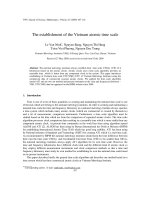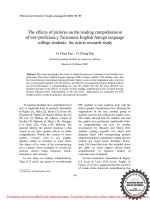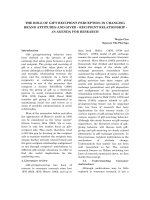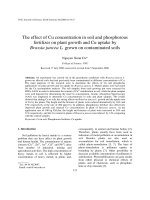Báo cáo "The effect of Cu concentration in soil and phosphorous fertilizer on plant growth and Cu uptake by Brassia juncea L. grown on contaminated soils " doc
Bạn đang xem bản rút gọn của tài liệu. Xem và tải ngay bản đầy đủ của tài liệu tại đây (120.43 KB, 5 trang )
VNUJournalofScience,EarthSciences24(2008)113‐117
113
The effect of Cu concentration in soil and phosphorous
fertilizer on plant growth and Cu uptake by
Brassia juncea L. grown on contaminated soils
Nguyen Xuan Cu*
College of Science, VNU
Received 17 July 2008; received in revised form 5 September 2008.
Abstract. An experiment was carried out in the greenhouse conditions with Brassica juncea L.
grown on alluvial soils that had previously been contaminated at different concentrations of Cu.
The main purposes of the research were to determine the effects of Cu and phosphorus
applications on plant growth and Cu uptake by Brassica juncea L. Mature plants were harvested
for the Cu accumulation analysis. The soil samples from each growing pot were extracted by
HNO
3
0.43N in order to determine the content of Cu
2+
mobilization in soil, while the plant samples
were acid digested for determining the total Cu concentration. Atomic Absorption Spectroscopy
(AAS) was employed to determine Cu concentrations in soils and plant samples. The results
showed that adding Cu to soils has strong effects on Brassica juncea L. growth and the uptake rate
of Cu by the plants. The height and the biomass of plants were reduced dramatically by 36% and
53% respectively at the rate of 200 ppm Cu. In addition, phosphorous fertilizer also effectively
improved plant growth and reduced Cu concentrations in plant of Brassica juncea. At the
application rate of 100 kg P
2
O
5
/ha, the height and biomass of plant were increased to 30% and
31% respectively, and the Cu content in plants of Brassica juncea was reduced by 14% comparing
with the control samples.
Keywords: Cu in soil; Phosphorous fertilizer; Cu uptake.
1. Introduction
*
Soil pollution by heavy metals is a serious
problem that can have affect on plant growth
and human health. The contaminants of majors
concern (Cu
2+
, Zn
2+
, As
2+
, Cd
2+
and Pb
2+
) arise
from number of industrial, mining and
agricultural activities. The high concentration of
heavy metals in soil is reflected by higher
concentration of heavy metals in plants and,
_______
*
Tel.: 84-913023097.
Email:
consequently, in animal and human bodies [2].
Therefore, plants usually have been used as
indicators of metal pollution or accumulation in
soil. Besides, plants are also used as
accumulators for soil remediation, which is
called phyto-remediation [5, 7]. The base of
phyto-remediation is pollutant uptake or
bounding by plants [7]. Other possibility to
decrease available concentration of pollutants is
stabilization. Phytostabilization can gain results
from either physical or chemical effects of
plants, and of chemicals, such as phosphate,
lime or clay minerals [3].
N.X.Cu/VNUJournalofScience,EarthSciences24(2008)113‐117
114
The examination of the heavy metal, i.e. Cd
and Zn on plant growth and uptake
investigated by Zhang et al., also assist to
elaborate a possible combination of phosphate
application on heavy metal uptake [1, 4]. The
main purpose of this research is to investigate
the relation between contents of Cu in soil and
Cu accumulation in plant, and also the role of
phosphate in reducing the uptake of Cu by
Brassica juncea L.
2. Materials and methods
2.1. Pot experiments
Alluvial soils collected for pot studies
originated (0-20 cm depth) from Quynh Do
Village (Thanh Tri District, Hanoi City) where
the soil is affected by waste water from Hanoi
City during agricultural production. The
chemical properties of soil for pot studies are:
CEC: 23 Cmol/kg, pH (KCl): 6.15, OM: 2.44%,
total N: 0.32%, total P
2
O
5
: 0.19%, total K
2
O:
1.02%, total Cu: 21.29 ppm, mobilization Cu
2+
(HNO
3
0.43N): 13.38 ppm.
The greenhouse experiment was carried out
in the 2007 year. The soil used for experiment
was artificially polluted by CuSO
4
with
significantly different rates of Cu application
(Table 1). Each pot with 5 kg of soil was sown
with seeds of Brassica juncea L. and water to
the moisture level of about 70-80% of the field
capacity.
Table 1. The treatments layout
Cu and phosphate added
Treatments
Fertilizers
(N+K
2
O) kg/ha
Cu (ppm) P
2
O
5
kg/ha
Trt.1 (75+30) 0 0
Trt.2 (75+30) 50 0
Trt.3 {75+30) 100 0
Trt.4 (75+30) 200 0
Trt.5 (75+30) 100 40
Trt.6 (75+30) 100 60
Trt.7 (75+30) 100 80
2.2. Sampling and chemical analysis
Plant and soil samples were taken and
analysed at the harvest time (45 days after
sowing). Plant samples (leaves and shoots) are
collected and washed with pure water and then
dried at 70
o
C until stabilisation of weight. The
monitoring indicators for plants growth include
plant height and biomass. Total Cu in soil and
plant tissues, Cu
2+
(HNO
3
0.43N) in soil was
determined by Atomic Absorption
Spectroscopy (AAS).
3. Results and discussion
3.1. Effects of Cu application on plan growth
and Cu accumulation in plant
The results of the effects of added Cu on
plant growth and heavy metal accumulation in
Brassica juncea L. plants are presented in Table
2. Some heavy metals, e.g. Cu, at a low dose
are essential microelement for plants, but in
higher doses they may cause metabolic
disorders and growth inhibition for most of
plant species.
Table 2. Effects of added Cu on plant growth and Cu
content in plants (fresh weight)
Plant
height
Plant
weight
Cu accumulation
in plant
Treatments
cm % g/pot % ppm %
Trt.1 19.5 100 70.3 100 2.8 100
Trt.2 15.0 77 55.9 80 3.2 115
Trt.3 14.7 75 50.0 71 5.2 190
Trt.4 12.5 64 33.1 47 8.5 308
The data in Table 2 show the effects of Cu
concentration in soil on the growth rate of
Brassica juncea L. The height of plants reaches
the highest value of 19.5 cm at Trt.1, and drops
dramatically to 12.5 cm at Trt.4 (drop by 36%)
following the rate of added Cu increasing to
200 ppm. The effects of added Cu on biomass
are the same way of the effects on the height of
N.X.Cu/VNUJournalofScience,EarthSciences24(2008)113‐117
115
plants. The biomass decrease by 53% at the
application rate of 200 ppm Cu (Trt.4)
compared to the control sample (Trt.1). It is clear
that there is a reduction of plant growth (plant
height and biomass of Brassica juncea L.) with
increasing concentration of Cu in soil. The
accumulation of heavy metal in plant tissues of
Brassica juncea L. is reflected the concentration
in soil. The contents of Cu in plant increase
upon the rates of Cu application, especially at
the high rate of Cu above 100 ppm. It can be
said that the increase of rate of Cu uptake and
accumulation in plants is much faster than the
decrease of rate of plant growth. For example,
the contents of Cu in plant increase by 208%
when the rate of Cu application increases to 200
ppm. Meanwhile, the rate of biomass decreases
only by 53%. The results showed that the
uptake of Cu by Brassica juncea L. plants
corresponded to the increasing level of Cu
contamination of soil, while the biomass was
reduced at the high level of Cu concentration.
3.2. Relationship between content of Cu
2+
in
soil with plant growth and Cu accumulation in
plant
The relationship between Cu concentration
in soil and biomass of Brassica juncea is
presented in Table 3. The highest plant height
and biomass is recognized at Trt.1 where the
mobilization of Cu
2+
(HNO
3
0.43 N) is about 13
ppm. But with a higher level of Cu
2+
in soil, the
growth rate of Brassica juncea decreases
significantly. This trend may be explained by
the toxicity of Cu to plant. These results might
be also used to evaluate the level of Cu
pollution in soil. Based on this experiment, one
can suggest that the phyto-toxic threshold of
Cu
2+
mobilization to Brassica juncea might be
listed at around 30 ppm, and serious effects can
be seen with the content higher than 50 ppm.
The relationship between Cu
2+
concentration in
soil and Cu content in plant shows a significant
positive effect (Fig. 1).
Table 3. The contents of Cu
2+
in soil, Cu content in
plant and plant height (fresh weight)
Trt Cu
2+
in soil
(ppm)
Plant height
(cm)
Biomass
(g/pot)
Cu content in
plant (ppm)
Trt.1 13.4 19.5 70.3 2.8
Trt.2 15.5 15.0 55.9 3.2
Trt.3 27.2 14.7 50.0 5.2
Trt.4 51.1 12.5 33.1 8.5
Cu content in plant
0
10
20
30
40
50
60
70
80
10 20 30 40 50
Cu
2+
in soil (ppm)
Plant height and Biomass
0
1
2
3
4
5
6
7
8
9
Plant height (cm)
Biomass (g/pot)
Cu content in plant (ppm)
Fig. 1. The relationship between Cu
2+
in soil with
plant height (Y
1
), biomass (Y
2
) and Cu content in
plant (Y
3
).
3.3. Effect of phosphate fertilizer on plant
growth and Cu accumulation in plant
In contrast with the results of Cu application,
phosphate fertilizers have a positive effect on
growth of Brassica juncea at all application
rates. The plant height and biomass of Brassica
juncea increase up to 130% and 131%
respectively comparing to the control sample
(Trt.3) without phosphate fertilizer (Table 4).
Table 4. The effects of added phosphorus on plant
growth and Cu accumulation in plants of Brassica
juncea (fresh weight)
Plant
height
Plant
weight
Cu content in
plant
Treatment
cm % g/pot % ppm %
Trt.3 14.7 100 50.0 100 5.2 100
Trt.5 16.3 114 53.1 106 5.1 98
Trt.6 17.4 118 57.3 115 4.8 92
Trt.7 19.1 130 65.5 131 4.5 86
N.X.Cu/VNUJournalofScience,EarthSciences24(2008)113‐117
116
The data in Table 4 show that phosphate
fertiliser not only improves the plant growth,
but also is the factor influencing on heavy metal
uptake by plant. The positive effects of
phosphate fertilizer on reducing Cu
accumulation in plant were recognized at all
rates of phosphate application. However, this
effect is significant only at rates greater than 60
kg P
2
O
5
/ha. At 100 kg P
2
O
5
/ha rate, the content
of Cu in plants of Brassica juncea is reduced by
14% compared to the control sample.
In general, there is a reduction in growth
rate of Brassica juncea when the content of Cu
in soil increases whereas the content of Cu in
plant decreases (Fig. 2). The data found in this
study indicated that Cu
2+
concentration in soil
has strong effects on the growth of Brassica
juncea even at moderate concentration of about
30 ppm.
4. Conclusions
The growth rate of Brassica juncea is
significantly affected by the Cu
2+
concentration
in soil at 30 ppm, and strongly affected by the
concentration at about 50 ppm which is
equivalent to the application rate of 200 ppm
Cu. The height and the biomass of plants are
reduced dramatically by 36% and 53%
respectively when the rate of added Cu
increases to 200 ppm. However, a further study
is needed in order to establish the maximum
amount of Cu that the plants to grow in these
soils.
In addition, a significant reduction of Cu
content in Brassica juncea is found when
phosphorous fertilizer application at the rate
higher than 80kg P
2
O
5
/ha. At the application
rate of 80kg P
2
O
5
/ha, the height and biomass of
plant are increased by 30% and 31%
respectively, and the content of Cu in plant is
reduced by 14% compared to the control
sample.
0
10
20
30
40
50
60
70
80
Trt.1 Trt.2 Trt.3 Trt.4 Trt.5 Trt.6 Trt.7
Plant height (cm)
Biomass (g/pot)
Cu in plant (ppm)
Fig. 2. Effects of Cu and phosphate fertilizer on
plant growth and Cu accumulation in plant of
Brassica.
Acknowledgements
The authors acknowledge financial support
of the Asian Center through funding from
Vietnam National University-Hanoi (VNU) for
conducting this research.
References
[1] V. Angelova, R. Ivanova, K.R. Ivanov, Study on
accumulation of heavy metals by plants in field
condition, Geophysical Research Abstracts,
Vol.7, 03931, 2005, European Geosciences
Union.
[2] D.A. Cataldo, R.E. Wildung, Soil and plant
factors influencing on the accumulation of heavy
metals by plants, Environmental health
Perspectives, 27 (1978) 149-159.
[3] S.B. Chen, M.G. Xu, 2002, Evaluation of
phosphate application on Pb, Cd, and Zn
bioavability in metal contaminated soil,
Environmental Ecotoxicity & Safety 1 (2006) 74.
[4] A. Lanfley, M. Gilbey, B. Kennedy (eds.),
Health and environmental assessment of
contaminated sites, Proceedings of the Fifth
National Workshop on the Assessment of Site
Contamination, National Environment Protection
Council Service Corporation, Adelaide, Australia,
2003.
N.X.Cu/VNUJournalofScience,EarthSciences24(2008)113‐117
117
[5] S.P. McGrath, F.J. Zhao, and E. Lombi,
Phytoremediation of metals, metalloids and
radionuclides, Advances in Agronomy 75 (2002) 1.
[6] R. Naidu, D. Oliver, S. McConnell, Heavy metal
phytotoxicity in soils, In: A. Lanfley, M. Gilbey,
B. Kennedy (eds.), Proceedings of the fifth
national workshop on the assessment of site
contamination, Adelaide SA 5000, 2003, 235.
[7] L.H. Wu, Y.M. Luon, X.R. Xing, and P.
Christie, EDTA enhanced phytoremediation of
heavy metal contaminated soil and associated
risk, Agriculture, Ecosystems & Environment
102 (2004) 307.









